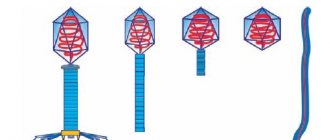Constipation in infants causes anxiety and worry among parents. Systemic treatment of the disease is prescribed by the doctor, having determined the cause. Constipation suppositories for newborns are used to eliminate symptoms; they help the baby get rid of feces, but have a one-time effect. Suppositories do not treat the underlying disease. Once in the intestines, they stimulate mucosal receptors and increase fecal mass. All this contributes to defecation. Rectal suppositories should not be used uncontrollably, since the baby will forget how to empty his bowels on his own.
Why is constipation dangerous?
Problems with bowel movements are a common problem among adults. In recent years, infants are increasingly encountering it. Cases of doctors prescribing suppositories are not uncommon. Constipation causes discomfort in the baby’s stomach and is dangerous due to other manifestations:
- Formation of cracks in the intestine - feces accumulate and become compacted, passing through the delicate mucosa, they scratch the membranes;
- Decreased immunity of the child, as a result of poor intestinal function, the body becomes vulnerable to diseases;
- Harmful substances that should be released with feces are absorbed into the blood, intoxication of the body occurs, and the general condition worsens;
- The intestines absorb nutrients and microelements worse.
In extremely rare and severe cases, the baby may experience rectal prolapse as a result of constant constipation.
Use of glycerin suppositories during pregnancy.
The instructions for glycerin suppositories indicate that they can be used during pregnancy according to indications. However, you should be careful: active stimulation of intestinal contractions during pregnancy is unsafe, since the colon and uterus have a common innervation and irritation of the rectal mucosa can lead to premature birth2. Microlax® microclysters do not have an irritating effect, but only soften dense feces, facilitating their removal. Thanks to this, Microlax® is suitable for pregnant women and nursing mothers.
Up to contents
When you need help
The use of suppositories for newborns for constipation depends on the type of feeding. If the baby is on artificial nutrition, then the absence of stool for two days is already a problem that needs to be dealt with.
The situation is different if the child is completely breastfed. Pediatricians believe that the absence of stool for up to 5 to 7 days can be considered normal. The fact is that breast milk is an ideal food for a baby; it is almost completely digestible. But this is possible if the baby has a good appetite, is not capricious and is active.
If the baby is breastfed, but whines, refuses to eat, squirms, tries to push and behaves restlessly, then even a two-day break in bowel movements is a reason to consult a doctor.
Glycerin suppositories, reviews of the drug
Reviews about this product are only positive. Suppositories are effective for stool retention and, unlike most laxatives, do not cause discomfort or pain. When seeking qualified help, doctors often prescribe Suppositoria Glycerini or Suppositoria cum Glycerino. These suppositories can be used for newborn babies, since in addition to glycerin, they contain stearic acid and sodium carbonate.
What candles will help a newborn baby?
Pediatricians distinguish three types of suppositories for babies. But it is strictly forbidden to use candles without a doctor’s recommendation. This can cause serious health problems.
- Glycerin suppositories are rectal suppositories based on glycerin and glycerol. Considered the safest. They can be used from three months of age. The instructions for the drug say that the principle of action is based on the fact that the suppositories dissolve and soften the feces due to the resulting liquid. They also irritate the nerve endings of the intestines, which promotes bowel movements. Glycerin is not absorbed into the mucous membrane and is released along with feces, acting locally. When used correctly, they practically do not cause side effects.
- Gas-forming suppositories for children - the action of this group of suppositories is based on the chemical properties of the active component. Sodium bicarbonate dissolves in the intestines and carbon dioxide bubbles form. They provoke contraction of the mucous membrane, as a result of which the child empties. Gas-forming suppositories are prohibited for newborns. A number of pediatricians advise them for children from the age of ten.
- Sea buckthorn suppositories are a preparation based on sea buckthorn oil. It is considered medicinal, relieves inflammation, and copes with pathogenic microorganisms. Additionally, suppositories cope with the problem of constipation, but the laxative function is less pronounced than that of other drugs.
Among the main inexpensive candles are:
- Glycerin, Glycerol, Glycelax - from the glycerol group;
- Ferrolax, Calciolax - names from gas-forming drugs.
What causes the laxative effect of glycerin suppositories?
Glycerin has the ability to irritate the mucous membrane in the rectum and thereby reflexively stimulate peristalsis and trigger the act of defecation2. Thus, glycerin suppositories are classified as irritating laxatives. But with constipation, it is not always possible to achieve bowel movement with the help of reflex stimulation due to hardening of the stool. It is worth noting that in this situation they not only turn out to be powerless, but can also cause harm because passing dense feces can injure the anus. Because of this, Vaseline is added to some suppositories, but it cannot fully soften dense feces.
Microlax® microclysters have a completely different mechanism of action: the components they contain do not irritate the rectum, but soften dense feces, facilitating their elimination. The effect of a microenema usually occurs within 5-15 minutes3.
Up to contents
How to light a candle correctly
Inserting a suppository seems like an easy procedure, but in fact, mothers should know a number of important rules. Following them will help you quickly and painlessly insert a rectal suppository.
- The baby is placed on his side, his legs are tucked in his chest. It turns out that the child is lying in the fetal position.
- The buttocks are spread apart with the fingers of one hand, and the suppository is quickly inserted with the other hand.
- The candle should be inserted with the tapered end. If there are bumps, scars or other protrusions on it, they should be softened and straightened with your fingers.
- After inserting the suppository, the buttocks are kept closed for several minutes. The fact is that the baby feels a foreign body and begins to push. The suppository will easily fall out of the rectum without even starting to act.
- Suppositories are stored in the refrigerator because they melt at room temperature. Before inserting the candle, you should hold it in your hands for a short time to warm it up.
The medicine quickly dissolves in the intestines and begins to act. Typically, defecation occurs within 20 to 30 minutes after using a rectal suppository.
Features of application
- Glycerin suppositories for adults come in a dosage of 1.5 mg, for children - 0.75 mg. Depending on your age, your doctor will prescribe the right dosage. Typically, a baby with constipation up to one year old is given one-fourth of a baby suppository once a day.
- Suppositories are inserted in the morning, twenty minutes after breakfast, this time is the most optimal for bowel movements.
- The procedure for inserting a suppository should not be repeated more than three times in a row.
- After the first use of the suppository, you need to monitor the child. If he experiences redness of the skin or a rash, then it is urgent to do an enema of clean water. The baby is allergic to one of the components of the candle.
Glycerin suppositories - composition and description
Glycerin suppositories have an oblong shape with a pointed front and a warmed end. Suppositories are white or milky, sometimes yellowish in color, and are hygroscopic. They are used only for the treatment process using rectal insertion. The package contains 10 pcs.
Suppositories are available in 2 forms:
- Children's 1.24 g. active substance;
- Adults containing 2.11 g.
The active substance in the medication is glycerin or glycerol. Additional elements include sodium carbonate dehydrate, stearic acid and polyethylene oxide 400.
Contraindications
Despite their effectiveness, rectal suppositories for newborns have limitations in their use:
- Age up to 3 months - the baby is born with a clean intestine, not populated by microorganisms. Gradually, the child gets used to and adapts to the world around him, and the functioning of his internal organs improves. Suppositories are still dangerous for babies, since it is impossible to determine the true cause of constipation at such an early age. The child may have an anatomically incorrect intestinal structure, and suppositories will only worsen the situation. In addition, they can cause an allergic reaction. For newborns, Microlax is prescribed - microenemas. They are allowed to be used from the very first days;
- Rectal fissures;
- Exacerbation of hemorrhoids;
- Intestinal tumors;
- Bleeding from the rectum;
- Individual intolerance to one of the components of the suppository.
Suppositories are always contraindicated in cases of chronic constipation - caused by physical factors. For example, feces are retained by a hernia or scar growth, etc.
In cases where it is not possible to use suppositories for constipation in newborns, doctors prescribe oral medications in the form of solutions or syrups, for example Duphalac.
You can find out about the dosages of the drug "Duphalac" in the article "Duphalac: instructions for use for children by age."
What are the medications for constipation for newborns?
Products with a laxative effect are produced for children from the first days of life. In pharmacies you can purchase medications in various forms: suppositories, syrups and solutions.
Candles
Candles for newborns for constipation
When the problem of bowel movement occurs rarely, children's doctors recommend purchasing rectal suppositories.
Their action occurs locally, and is not so safe for the rest of the body. It is recommended to use glycerin-based suppositories. Used for constipation in babies up to a month old, 1/8 part. From the age of one month, it is allowed to double the dosage.
Suppositories can soften stool and ensure a softer and more painless bowel movement process.
Solutions and syrups
It is important to choose the one from many brands that will really help your baby. Mothers will be helped by a note about the age category of the drug. It is also necessary to carefully study the instructions for use, and, if possible, do not use the medications yourself without a doctor’s prescription.
Laxative Prelax
Prelax - the drug contains lactulose. It improves intestinal motility and improves its natural microflora. After administration, the drug takes effect within an hour. It can also be taken as a preventative.
Normolact is a lactulose-based laxative. The drug is given to the child starting with a high dose, then it is reduced if the desired result is visible. The medicine is not addictive and can be used for a long time.
Duphalac is a laxative made from natural ingredients. The syrup can be used in the treatment of constipation from the first days of a child’s life. The maximum effect of the medicine is achieved within 24 hours after taking it.
How to normalize stool
- If the baby is completely breastfed, then it is necessary to adjust the mother’s diet. They should eat laxative foods: prunes, dried apricots, carrots, beets. But first you need to eat very little to check if there is an allergy to the new product.
- Introducing water - if there is a lack of fluid in newborns, constipation is possible.
- For babies on artificial feeding, it is worth changing the mixture, choosing one with the addition of lactobacilli.
- Children older than six months who are additionally fed need to be introduced to vegetables and fruits. Introduction of complementary foods according to age: zucchini, pumpkin, apples, prunes. Fermented milk products will also help normalize microflora.
- A tummy massage will help improve peristalsis - you need to carefully make circular movements clockwise.
Constipation suppositories for newborns are prohibited under the age of 3 months. They are used only after the recommendation of a doctor. They help cope with the proctogenic type of disease - caused by systematic intestinal disorders, when feces have already collected, and the brain does not receive a signal about the need to contract the mucous membrane. Regular use leads to addiction. Suppositories remove stool, but do not treat the cause of constipation.
We also recommend reading the article:
- Anti-constipation medications for children: review of the most effective ones
- Folk remedies for constipation for children - the best recipes
Be healthy!
Glycelax for children - life without constipation
Constipation is one of the most common diseases of the digestive tract in children and adults. There are many reasons that provoke a violation of the movement of feces. This could be some kind of obstruction in the intestinal lumen, endocrinological or neurological disorders, infectious diseases, etc. Depending on the cause of constipation, treatment is selected to combat it.
What is constipation?
The answer to this question seems obvious. Constipation is an infrequent bowel movement. However, modern medicine understands constipation not only as a decrease in stool frequency, but also as unfavorable changes in its character. Too hard, dry stools and/or painful bowel movements are also considered constipation, even if the child walks a lot every day.
You should consult a doctor if your child experiences:
- from birth to 6 weeks, stool less than once a day;
- on exclusive breastfeeding from 6 weeks to 6 months, stool less than once every 5 days (Breast milk is very well absorbed, so in such babies, bowel movements may occur quite rarely, since feces are formed more slowly. But this only applies to breastfed children feeding before the introduction of complementary foods!);
- 1 year – 3 years stool less than 5–6 times a week;
- over 3 years of age, bowel movements less than 3–4 times a week;
- at any age, painful bowel movements, as well as stools mixed with scarlet blood;
- abdominal pain that goes away after bowel movements;
- dense, dry or excessively bulky, “thick” stools.
If such symptoms appear, you should definitely consult a doctor - a pediatrician or pediatric gastroenterologist. Only a specialist, after examining the child and, if necessary, prescribing additional tests and examinations, will be able to find the cause of bowel dysfunction and recommend treatment.
How to help your baby
The doctor will select the main treatment. And before visiting him, you can do the following.
1. Monitor the child’s drinking regime.
One of the common causes of constipation is lack of fluid. To ensure the required amount of water, you need to exclude teas, sweet drinks, soda and offer plain water as a drink as often as possible. If the baby flatly refuses to drink it, you can give him 1-2 spoons of water every 30-60 minutes. It’s not difficult to drink two spoons, and within a day the required amount of liquid will be gained at this rate.
2. Analyze the child’s nutrition, increase the amount of foods rich in dietary fiber.
A deficiency of dietary fiber causes constipation in both children and adults. Experts recommend that preschoolers and schoolchildren eat up to 300 g of vegetables daily (excluding potatoes!) and about 200 g of fruit. These can be salads, vegetable side dishes (including those made from frozen vegetables!), fruit desserts and even baked goods with the addition of not only fruits or berries, but also, for example, grated carrots, pumpkin or beets.
For young children, in addition to the presence of vegetables and fruits in their diet, it is also necessary to check the consistency of the food. Food that is excessively crushed or pureed also causes constipation. From 8–12 months, children can and should eat dishes with cereals, small soft pieces of vegetables, meat, etc.
3. Use children's laxatives to restore regular bowel movements and prevent the development of painful bowel movements, which only worsen the problem.
If a child experiences discomfort, complains of abdominal pain, strains intensely, or, conversely, suppresses the urge to defecate, fearing that it will be painful, the baby should be given a laxative. In order not to injure the delicate intestinal mucosa, avoid enemas or irritation of the anus with foreign objects (a bar of soap, a cotton swab with Vaseline, etc.). It would be more correct to use such a proven remedy as suppositories with glycerin.
Glycerin softens stool, enhances bowel movements and accelerates the passage of stool, and lubricates the rectal mucosa. Moreover, there is a special children's form of such suppositories - Glycelax for children.
Glycelax for children:
- is not absorbed, which means it does not have a negative effect on the child’s body as a whole;
- simple and easy to use, and 1 candle per day is enough to solve the problem;
- loosens stools within an hour (usually in the first 15–45 minutes) after using the suppository;
- does not contain dyes or flavors;
- Allowed for children from 3 months.
There are contraindications, it is necessary to consult a specialist.
Product by topic:[product](Glycelax 0.75 N10 SUPP RECT D/DET)











